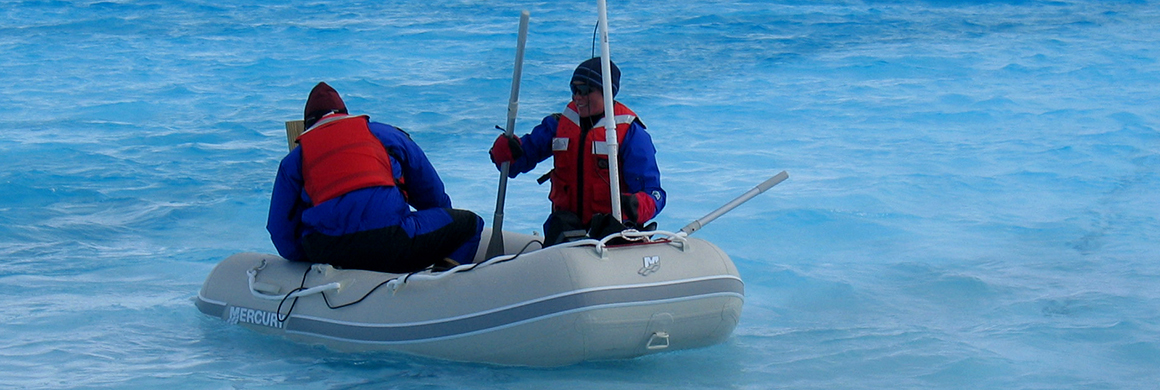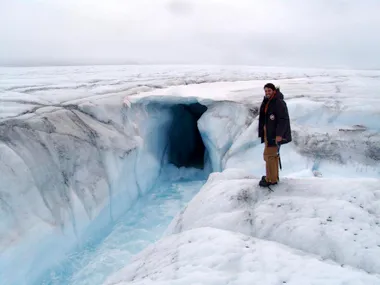Greenland's Ice Is Melting
The Arctic is warming more rapidly than other regions. For example, while Earth’s average temperature has increased by one degree Fahrenheit over the past century, air temperature in Greenland has increased by about seven degrees Fahrenheit since 1991. Because warming is more rapid in the Arctic, the impacts are much more pronounced.
Greenland sits between the Arctic and Atlantic Oceans and is almost entirely covered with ice. A massive ice sheet blankets about 80% of the land surface, but in recent decades, the ice has been getting thinner, glaciers are retreating at the edges of the ice sheet, and it is melting at its top.

Rocky ridges and the Greenland Ice Sheet.
NASA
Earth’s warming climate means that overall Greenland loses more ice than it gains each year. Warmer temperatures mean more melt days. During summer, temperatures are warm enough for ice on the surface of the Greenland ice sheet to melt in many places. Warmer temperatures have lead to more days of melting ice. Areas losing the most ice are located in southern Greenland and along the margin of the ice sheet. Greenland is currently losing 234 billion tons of ice per year. That's enough ice to pack into 6,324 Empire State Buildings. Ice is melting seven times faster now than it was in the 1990s.
Greenland’s accelerating rate of ice melt is one of many major changes in the region. The amount of sea ice in the Arctic Ocean has been decreasing in recent decades. Permafrost in Arctic tundra has been thawing rapidly too. And warming is causing changes to Arctic ecosystems and human communities.

Does this look like Greenland to you? These researchers are studying a lake on top of the Greenland ice sheet. Lakes like this one are becoming increasingly common as warmer temperatures cause melting on the surface of the ice sheet.
Joughin/UW Polar Science Center
All that melt water has to go somewhere.

Dr. Alberto Behar stands by opening of a moulin on the Greenland ice sheet.
NASA/JPL
Researchers were amazed to discover that melt ponds at the surface of the ice can disappear entirely in an hour or two. The water drains from the pond to the bottom of the ice sheet via chutes through the ice called moulins. Glaciologists suspect that melt water that flows to the bottom of the ice sheet through the moulins reduces friction, allowing the ice to move more quickly over the rocky surface. Researchers have noticed that the number of moulins is increasing.
As the glacier accelerates, it pushes ice into the ocean. The melt water draining to the bottom of the ice through moulins causes the ice to slip more quickly towards the ocean - a bit like slipping on a banana peel. Outlet glaciers, the routes that ice takes towards the sea, are moving more quickly now than they were in the past. For example, a large outlet glacier on the west side of Greenland, called the Jacobshavn Glacier, has nearly doubled its speed in the last decade. The flow velocity of other glaciers has increased by up to 50% during the summer melt period.
So the melt water contributes to rising sea level in two ways: (1) water from the ice surface finds its way to the ocean, contributing directly to sea level rise, and (2) the water's ability to speed flowing glacial ice towards the ocean also contributes to sea level rise. If all the ice that is on Greenland were to melt or calve into the ocean, global sea level would rise 7.2 meters (23.6 feet). Melting Greenland ice increases global sea level by at least 0.5 millimeters each year, though recent studies suggest this rate may be increasing. Scientists anticipate that even if greenhouse gas emissions could be cut to zero in the 2020s, Greenland’s melting ice would still contribute to at least 0.27 meters (0.90 feet) of sea level rise over the next century.